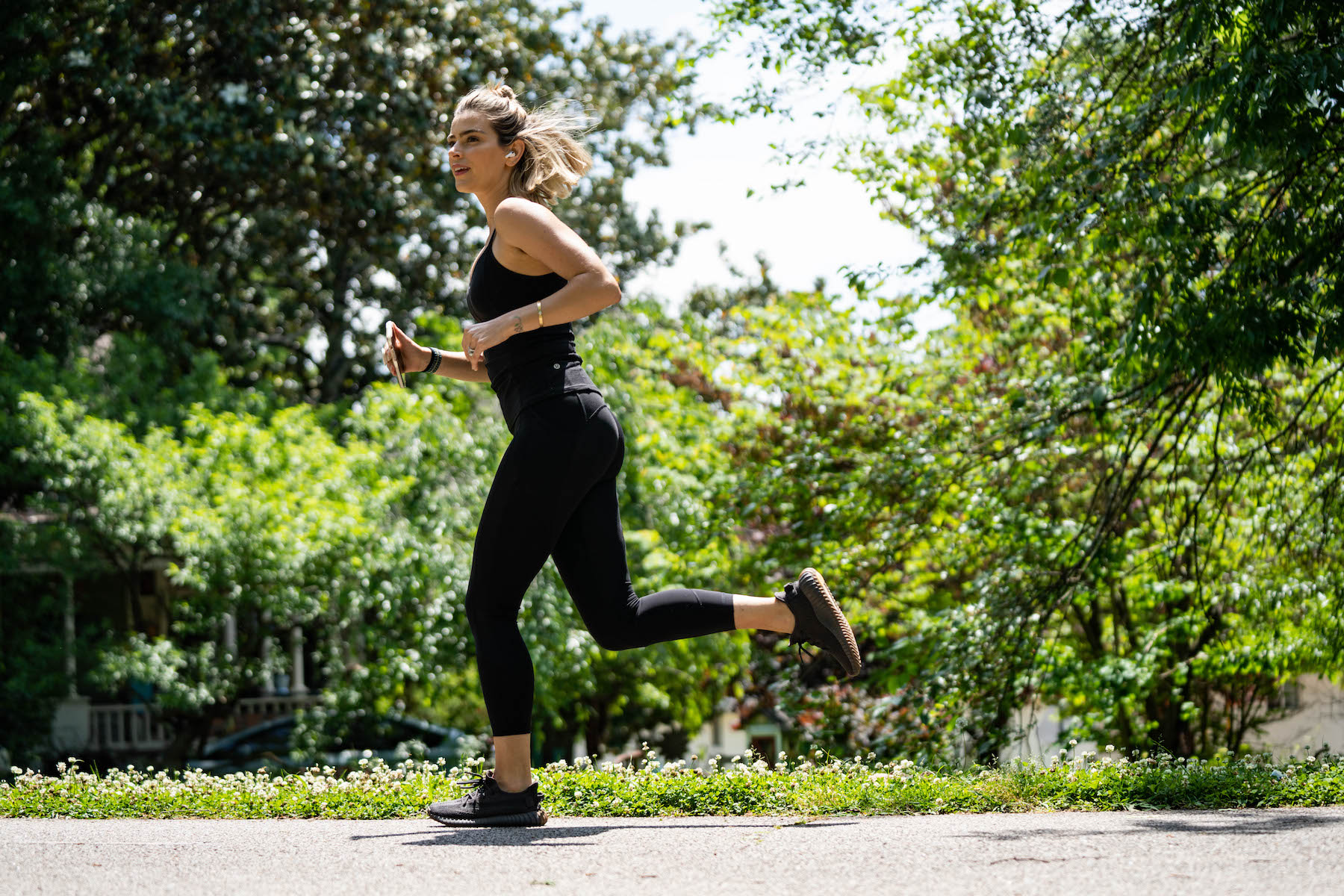
How to Breathe While Running: Tips and Techniques to Breathe Easy
Master these breathing techniques to make every run feel easier.
By Karen Asp, Kells McPhillips•
Why Is It So Difficult to Breathe While Running, Anyway?
The Basics of Breathing While Running
The Best Breathing Techniques for Running
What to Do If You Feel Out of Breath While Running
The Takeaway
Every day, you take about 20,000 breaths, according to the American Lung Association. Yet how many times during the day do you stop and think about your breath? Probably never—until that is, you start exerting yourself in activities like running, for instance. Breathing while running can be challenging, but learn how to breathe properly while running and you might just improve your running performance overall.
If you’re new to running, you’ve probably already found that you’re paying more attention to your breathing than normal, and that’s a good thing. “I think of breathing as an awareness cue,” says Jeffrey McEachern, a Peloton running instructor. “You’re aware that your body is moving, and that breath then serves as an anchor, along with mindset and posture, that can carry you through the run.”
In fact, how you breathe when you run can make you more—or less—successful in your running endeavors. And although you already know how to breathe, just a few tweaks can help you master the best breathing techniques for running.
Why Is It So Difficult to Breathe While Running, Anyway?
Anyone who has gone for a run, regardless of the distance or speed, understands how much demand running places on your lungs. Yet why is breathing so difficult when you run?
To answer that question, you have to learn a little about physiology. “To be able to run for more than 12 seconds, the average time to exhaustion of anaerobic exercise, the body needs oxygen to convert, produce, and release energy to the working muscles,” says Joseph McConkey, Boston Running Center exercise physiologist and author of Pliability for Runners. “To work efficiently, this aerobic system requires many components to run smoothly, including long and dilated capillaries, oxygen-rich blood, and an inflammation-free soft-tissue system.”
If you’re a runner who has trained consistently and smartly, you’ve adapted and developed the characteristics mentioned above so that easy running requires less energy and thus a slower breath rate. However, if you’re new to running or haven’t trained wisely, your muscles will be asking for oxygen at a rate that your body can’t deliver. The result? “Your breathing rate will increase as your lungs struggle to keep up with the demand,” McConkey says.
For some individuals, though, the biggest challenge with breathing happens at the start of their run, and there’s a reason for that. “There’s likely hypertension, inflammation, and/or a lack of muscle coordination,” McConkey says. All of these can inhibit your muscles from functioning as well as they should. The good news, though, is that after five to 10 minutes of running, your breathing should improve. (So if you’re feeling discouraged early on, this is your sign to stick with it!)
You can also take steps to prevent these issues during the first part of your run by doing a pre-run foam rolling session and active warm-up walk where you walk with a variety of different steps or drills. For instance, you might walk with high knees, wide steps, or low steps.
You can also use the Peloton App to find Warm Up Walks in the Outdoor section, or if you have a Peloton Tread or Peloton Tread+, check out any of the 5 and 10-minute Warm Up Walks available.
The Basics of Breathing While Running
So what is the best way to breathe while running? It’s more straightforward than you might think. Follow these four tips for how to breathe properly while running and you’ll be well on your way.
1. Utilize Belly Breathing
Ensure you are using diaphragmatic breathing, which means you’re breathing deeply from your belly by contracting your diaphragm. Sounds complicated, yes? Not really. “Typically, this happens by simply not thinking about it,” McConkey says.
2. Consider Your Posture
Posture plays an important role in helping you breathe better while running. If you’re using poor posture, perhaps leaning forward excessively, your lungs won’t be able to fully expand, oxygen won’t circulate throughout your lungs as it should, and your running performance will be hindered, McConkey says.
Instead, keep your posture upright to allow for better circulation of oxygen into your lungs, says Peloton instructor Jermaine Johnson. Another benefit of using good posture? “You’ll automatically feel stronger and more confident,” Jeffrey says. That’s why he likes to cue students in his classes to avoid looking down when running. Instead, keep your gaze fixed straight ahead of you.
3. Don’t Skip Your Warm Up and Cool Down
Finally, just as you warm up your body, you also need to warm up and cool down your breath. Jeffrey likes to start the breathing process when he’s getting changed into his running clothes. He takes a minute or two while changing to do some deeper breathing and exercises that open up the chest before moving into movements like jumping jacks to get his whole body ready for the run. Then after he runs, he’ll walk for a short time until his breath resumes its normal pattern. (You can find Cool Down Walks on the Peloton App.)

Peloton App
Access thousands of classes with no equipment needed.
The Best Breathing Techniques for Running
Again, when it comes to running, experts like to talk about diaphragmatic or “belly” breathing, which involves inhaling deeply until you feel your stomach rise, then gently exhaling. This style of breathing gives your body more oxygen to tackle the miles ahead. So if you’re new to running, the simplest way to breathe is just to make sure you’re inhaling deep in your belly and exhaling slowly. But if you’re looking for new breathing techniques for running, there are a few more you can try.
Rhythmic Breathing
As you run, you should establish a rhythm to your breathing, something that can be easily measured by the number of steps between exhales and inhales. “This rhythm means you’re running at a steady state where the demands from the muscles are being met by your cardiorespiratory system,” McConkey says.
So how do you do it? Align an exhale with a foot strike. Then notice how many steps are between your exhales (typically three to five steps). Now use this rhythm to count your exhales to 100. “It’s a great technique to get into rhythm, build your focus, and distract yourself from the rigors of running,” McConkey says.
You can then experiment to see what type of rhythm works best for your breath. “Your body will automatically adjust to the beat, so do what feels natural to you,” says Jeffrey, who likes to program his runs to music with a tempo that can help him keep this rhythm. When he does higher-intensity runs, for instance, he likes to follow a two-two breathing cycle, inhaling for two steps and exhaling for two. If, though, he’s doing a longer, slower run, he’ll switch to four-four breathing, inhaling and exhaling for four steps each.
Breathe and Count
If counting between steps feels like too much work mid-run, try matching the lengths of your inhales with the length of your exhales. For example, inhale for a count of five and exhale for a count of five. Like many breathing exercises, this measured approach can activate the parasympathetic nervous system, which may calm your body and improve exercise performance.
During easier mileage, you can even add a pause at the top of your inhale and the bottom of your exhale. Experiment and find what feels good for you, knowing that some days may require different counting techniques than others.
Experiment with Breathing Through Your Nose and Mouth
You’ve probably wondered if it’s better to breathe through your mouth or nose when running. Some research suggests that breathing only through your nose may help your body use less oxygen as you run. In other words, this technique can improve your running efficiency during easy or moderate runs.
McConkey has a different approach. “Runners should always breathe in and out of their mouth and nose, so keep your mouth open,” he says, adding that no elite runner has ever raced with their mouth closed. “To run your best, you need to inhale as much oxygen and exhale as much carbon dioxide as quickly and in as large amounts as possible.”
It will ultimately take patience to discover what type of breathing suits you and your goals. Maybe you find that nasal breathing is ideal for easy runs, but you need to rely on bigger breaths when you pick up the pace. Alternatively, you may just decide that breathing through your mouth is the most comfortable.
What to Do If You Feel Out of Breath While Running
We’ve all been there: You’re in the middle of a run when suddenly your body starts to feel heavy and your breaths become short. When this happens, take a moment to judge how you’re feeling. If you’re uncomfortable but otherwise okay, slow your pace and focus on that deep belly breathing until your breathing starts to feel normal again.
If you simply can’t catch your breath, it’s time to stand still or walk. One recovery posture that researchers found improves heart rate recovery is placing your hands on your knees. To do so, place your hands on your knees with your elbows locked and your thoracic spine curved. Focus on your breathing by taking a deep breath in through your nose, then exhaling deeply out of your mouth. Wait until you’re fully recovered to return to your run.
If you find that you’re running out of breath frequently on your runs, it’s likely due to your pace and breathing. Remember that the vast majority of your mileage should be done at an easy, conversational pace. Meaning, if you’re out of breath, you’re probably going a little harder than necessary. Slow down until your pace almost feels effortless (think: two or three out of ten) and go back to your breathing.
Another method that can help you build up your pace is the run-walk method, a type of training where you run for an interval (say three minutes) before recovering for an interval (say one minute). Over time, your body will learn how to run efficiently for longer, and you may be able to slowly bump up those intervals until you can go miles without stopping. If you’re still struggling with your breath while running, consult your physician.
The Takeaway
By staying focused on your breathing as you run, you can help maintain that steady flow of oxygen to your muscles, which comes with numerous benefits. “This will help keep your foot turnover strong and your body relaxed, allowing you to run with more power and efficiency, even as you fatigue,” Jermaine says.
Just remember to maintain good posture, find a natural breathing rhythm, and don’t give up too soon. Do those three things, and you’ll find that running will be a much more enjoyable experience and the time will fly by.
Related Articles
This content is for informational and educational purposes only and does not constitute individualized advice. It is not intended to replace professional medical evaluation, diagnosis, or treatment. Seek the advice of your physician for questions you may have regarding your health or a medical condition. If you are having a medical emergency, call your physician or 911 immediately.
Level up your inbox.
Subscribe for a weekly dose of fitness, plus the latest promos, launches, and events.
By providing your email address, you agree to receive marketing communications from Peloton.
For more about how we use your information, see our Privacy Policy.









